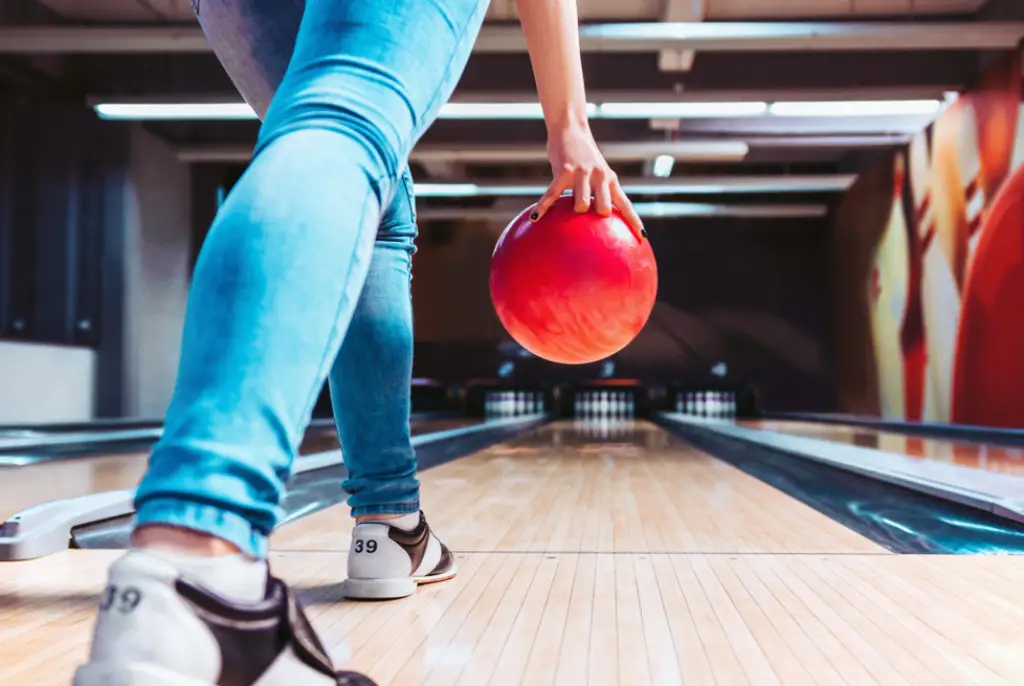Some people believe there are bowling balls resistant to oil absorption, is this the truth? Here we try to reveal a mystery and learn if balls need removing oil from a bowling lane.
The material of a ball influences how much oil a ball can absorb. Pearl bowling balls soak up more oil than urethane or plastic balls.
Pearl bowling balls absorb oil the most among bowling equipment. Urethane coverstock is more durable and has a lower density than solid or pearl balls. Plastic bowling balls don’t soak as much oil as other materials.

Want to skip ahead to a particular section?
Why do bowling balls absorb oil?
Lane surfaces are covered by oil to allow the ball to glide. A bowling ball rolls, absorbs oil to show its best performance. The amount of lane oil regulates how the ball curves and its behavior.
Each bowling ball absorbs oil. Without proper lubricant, the ball won’t be able to slide freely and predictably. This means to get a predictable ball action, you should know how much oil a ball takes. Balls with high absorption require oily lanes to show the best game.

What type of bowling ball absorbs oil the most?
Reactive resin balls absorb oil the most. Nowadays, there are 3 types of bowling balls. Balls with a solid covers, pearlized balls, and plastic ones.
Advanced bowlers claim that pearlized balls are the most durable and the most absorbing oil, moreover, they can withstand the weight of thicker oil than others. Most reactive resin balls may carry down much oil down the lane as plastic or polyurethane balls do.
On the track, the pearlized ball slowly absorbs most oil thanks to its pearl coverstock. Then it can easily glide down the lane. And react quickly on dry areas of a path as needed. Such increased friction helps to knock pins down with more power.

Pearl bowling balls
Pearl reactive bowling balls are perfect to use on natural length due to their ability to react quickly in oily conditions and to a breakdown in dry areas. A reactive tool shines as a pearl thanks to the mica. It is the best bowling ball for dry paths, cause such bowling balls absorb oil the best.
How do pearl balls differ from solid balls?
A solid reactive cover is more oil-resistant than a pearl one. It provokes losing more energy moving down the lane. The solid coverstock is better used with pearls, driving the lane, it can easily penetrate oil. So pearl balls are perfectly suitable for surfaces with too much oil for a better bowling speed and proper reaction.
Does urethane coverstock absorb oil?
An urethane ball is better oil resistant as it is less porous than a pearlized bowling ball. When you roll it down a lane, the oil rings surrounding the track don’t absorb so much oil. Due to little amount of absorption, the ball concentrates more on carry-on.

Does plastic coverstock absorb oil?
Plastic is the most oil-resistant material due to its non-porous coverstock. Polyester molecules have no contact with oils.
Some bowlers call plastic bowling balls “carry down”. They pick a little amount of oil but do not absorb it. So, plastic bowling balls are the most suitable for beginners as even on heavy oil lanes they act predictably.
What does oil do to a bowling ball?
Thinking about an attractive bowling game, we all imagine a shiny lane and gracefully moving bright bowling balls along it. But what conditions should be fulfilled to observe such a game? Using appropriate materials to add beauty and glance is great, but a slippery ball motion cannot be fulfilled without any lubricant.
The manufacturers renewed the composition of bowling balls for better sliding and created oiling patterns to interact with different coverstocks. And it is a known fact that the slicker bowling paths are, the better bowling balls roll down, behaving and reaching the pins exactly as you wanted them.
But that doesn’t mean the more oil is added, the better performance is. Different balls behave the best in various lane conditions. Pearl reactive balls show their best motions on dry lanes, and urethane ones behave brilliantly on greasy lanes. So, it is best to combine covers during the game. A bowling game has no right or wrong shots. So, be ready to change the equipment to succeed with differently oiled lanes.

Does oil absorption ruin a bowling ball?
A bowling ball will absorb water, dust, and oil, but these won’t ruin the coverstock of the bowling vehicle. Too much oil influences the performance of a ball, cause it rolls slowlier and more unpredictably, and can be hit with more power.
Pay attention to a material of a bowling ball you use, and no matter if it is a plastic ball or a reactive resin due to oil absorption, all bowling balls require regular cleaning. It is up to you in what condition the ball is.
Do not forget to use wipes, sprays, or simply warm water to arrange a regular cleaning for your bowling friend to maintain it in good condition to perform well each time. Oil absorption doesn’t damage a ball, but it ruins your perception. Are you ok with using dirty and oiled tools? I believe that not.

Can I prevent my bowling ball from absorbing oil?
No, but you can arrange to control the track to receive enough oil and maintain your bowling tool for better and long-lasting performance. Or you can use a lane conditioner to reduce absorption. It helps to create a kind of barrier between the ball and the lane surface that leads to less oil absorption.
Lane conditioners may be found in any local sports goods stores or are available at most bowling alleys.

How to remove oil from my bowling ball?
When it comes to keeping your bowling vehicle in tip-top condition, there are several methods you can follow without any extra expenses or affords by yourself.
Ball spray
It seems to be the most natural and the simplest method to remove the oil at home by ball spray. Find a spray bottle, pour in it the equal parts of warm water and rubbing alcohol, and gently mix and wipe your ball any time it requires. You may use such a method to clean the bowling ball during the game or before each shot, depending on how oiled the lane is.
Rubbing alcohol
When you are at home and eager to remove excess oil from your bowling gear, you may easily prepare a bath for it. Prepare a proportion of 4 parts rubbing alcohol and 2 parts of hot water in a deep bucket or basin. Dip, rotate, and remove oil from your bowling ball. Then dry it or leave it outside until the next bowling day.
Rubbing alcohol as well as ball spray might be used outside when you extra need to apply a fresh coat of polish to the outer cover after cleaning.

Immersion method
It is one of the most effective ways to remove oil from your ball at home. Prepare the necessary equipment such as a bucket, wipes, tapes, and hot water. Fill in a big enough bucket with hot water, and add a bit of soap or dish detergent. Keep in mind that some chemicals might be too harsh and strip the outer layer of your ball.
To keep the finger holes secure, use water-resistant tape. Allow your ball to take a bath in hot and soapy water for 30 minutes. In this case, the oil can be released through the pores. After the surface grit is decreased, remove the water from the bucket with dawn soap and pour clean for washing the bowling ball.
Remove the excess water with microfiber wipes, as they won’t leave any scratches. The immersion method allows you to remove the oil and also refresh the cover of a ball.

Professional or home removing oil
There is a significant difference between the way you choose to remove excess oil. Professional cleaning services have a better idea of how, why, and how much oil different types of bowling balls absorb.
Professional cleaning costs about 5 to 10 dollars and resurfacing costs up to 30 dollars. Indeed, it is not a that big amount of money but worth it at least from time to time. After such procedures, the bowling ball usually renews its previous reaction to the lane.

How often should I remove the oil from my bowling ball?
I always have a simple cloth with water and dish soap, rubbing alcohol to remove oil from my bowling ball every 3-5 shots.
I suggest to clean bowling ball regularly, play on lanes with oil. If the lane is normal to dry, washing every seventy-five games will better extend the beauty, shape, and lifespan of your bowling ball. Too much oil in pores decrease the speed of a ball and change its shape into a worse condition.
At home, I prefer immersion way, cause it works great to extract oil from a bowling ball and once-twice a year I apply for a pros cleaning.
Read the article Do Bowling Balls Absorb Oil? to get more tips!

Do all bowling balls absorb oil?
Yes, all bowling balls absorb oil, but in different amounts. The coverstock contains tiny pores that absorb oil from bowling lanes as well as dust, dirt, and water. Different balls absorb less oil, such as plastic or urethane bowling balls, due to their weight and porosity of the material.
What is a high volume of oil in bowling?
Each bowling lane requires oil to protect the surface and for providing better bowling ball sliding. Oil patterns usually come from 20 to 30 millimeters. The higher oil volume requires a more aggressive ball, and the lower level of oil quantity is suitable for light softballs.
Can a bowling ball fully saturate with lane oil?
No, it can’t. No matter how old the ball is, only the outer part absorbs oil, but not the core. Some people presume that after thousands of bowling games a ball may fully saturate with oil, but it is only if it stays without cleaning for a long time. Such a ball cannot be in a game due to its inappropriate shape, properties, and look.
Do urethane balls absorb oil?
Yes, an urethane ball absorbs much oil due to its porosity. It works ideal for greasy lanes. Oil helps to generate friction between the ball and the lane, due to which the ball’s hook potential appears.
Do plastic bowling balls absorb oil?
Yes, they absorb the least among other materials, due to the properties of the light material and their weight.
Conclusion
Each bowling ball absorbs oil, but the amount depends on the material. Be sure, the oil won’t ruin the cover. Without oil absorption, any ball won’t have the ability to hold the lane. Decreasing friction thanks to oily lanes, the ball shows more predictability and firm contact with the surface.
You may be interested in – The best bowling ball on dry lanes: Which ball to choose?






